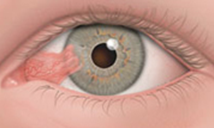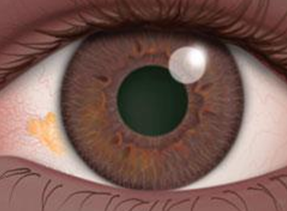 The pterygium and pinguecula are growths or tumors in the cornea (the transparent front window of the eye) and the conjunctiva (the thin transparent membrane covering the sclera or part of the eye). These tumors are non-cancerous and quite common.
The pterygium and pinguecula are growths or tumors in the cornea (the transparent front window of the eye) and the conjunctiva (the thin transparent membrane covering the sclera or part of the eye). These tumors are non-cancerous and quite common.
The pinguecula (above) is a patch or yellowish bulge in the conjunctiva, near the cornea. It most often appears on the side of the eye closest to the nose. It is a change in normal tissue that transforms into a deposit of protein, fat and / or calcium, very similar to a callus on the skin.
Pterygium is a growth of fleshy tissue triangular on the white part of the eye, which over time can extend over the cornea. This tumor may remain small, or grow large enough to interfere with vision. Often, a pterygium develops from a pinguecula.
Some pterygia may become red and swollen and some may become large and thick, producing a foreign body sensation in the eye. If the pterygium is large enough, it can affect the shape of the surface of the cornea, causing astigmatism.
The causes of the development of pterygium and pinguecula are not yet clear. It is believed that the ultraviolet (UV) light of the sun may be a factor in the development of these tumors. Other factors believed to cause pterygium and pinguecula are xerophthalmia (the condition of dry eye) and environmental elements such as wind and dust.
Symptoms of Pinguecula and Pterygium
Jan. 17, 2012
 In most people, the first sign of pinguecula is a patch or yellowish bulge in the conjunctiva, usually in the part of the eye closest to the nose.
In most people, the first sign of pinguecula is a patch or yellowish bulge in the conjunctiva, usually in the part of the eye closest to the nose.
Usually, the pinguecula has few symptoms, however, if it is irritated, it can produce the sensation of having a foreign body in the eye. In some cases, the pinguecula may become inflamed. Irritation and redness of the eyes can occur, especially if the eye is exposed to the sun, wind, dust or a very dry environment.
When there is a pterygium, some people can develop the tumor and have no other symptoms. For others, especially those who have a growing pterygium, there may be redness, swelling or both.
Other symptoms may include:
- Blurry vision;
- Itchiness;
- Stinging;
- Sandy feeling in the eye;
- Sensation of foreign body in the eye.
Diagnosis and Treatment of Pinguecula and Pterygium
Mar. 10, 2014
An ophthalmologist (eye doctor) can diagnose the pterygium and pinguecula by examining you with a slit lamp (photo on the left). This device allows your ophthalmologist to closely examine the cornea, iris, lens, and the space between the iris and the cornea. The doctor can examine the eye closely in small sections, making it easier to see abnormalities.
Pterygium and pinguecula usually do not require treatment until symptoms are severe enough. When a pinguecula or a pterygium becomes red and irritated, the use of lubricating eye drops or ointments, or possibly the application of drops with soft steroids can be used to help reduce inflammation.
If these tumors are large enough to cause persistent visual problems or discomfort, they can be surgically removed by an ophthalmologist during an outpatient procedure. Sometimes they are removed for cosmetic reasons.
When the pterygium is mild, a topical anesthetic may be used before surgery to numb the surface of the eye. Your eyelids will remain open, while the pterygium is surgically excised. After the procedure, which usually lasts no more than half an hour, you may need to wear a protective patch over your eye for a day or two. You should be able to resume your normal work activities the next day. Keep in mind that removal of a pterygium can cause astigmatism or worsen the condition in people who already have this refractive error.
After removing the pterygium, steroid eye drops can be used for several weeks to decrease swelling and prevent a recurrence of the tumor
Although a pinguecula or pterygium has been removed surgically, they may appear again. In fact, the rate of recurrence is between 30 and 40 percent, and is even more likely among people under 40 years of age. To avoid a recurrence after surgery, your Eye Doctor can suture or glue a piece of tissue from the ocular surface over the affected area. This method, called autologous conjunctival autograft, has a low rate of recurrence.
Drugs that prevent tissue growth are also sometimes used to help prevent the recurrence of pterygium and pinguecula.
The best way to avoid recurrence of pterygium or pinguecula after treatment is to limit exposure to environmental factors that contribute to its growth. This includes:
- Adequate protection of your eyes against excess ultraviolet light by the use of wraparound sunglasses;
- Protecting your eyes against dry and dusty conditions by wearing proper eyeglasses;
- Apply artificial tears to the eyes when you are in a dry place.